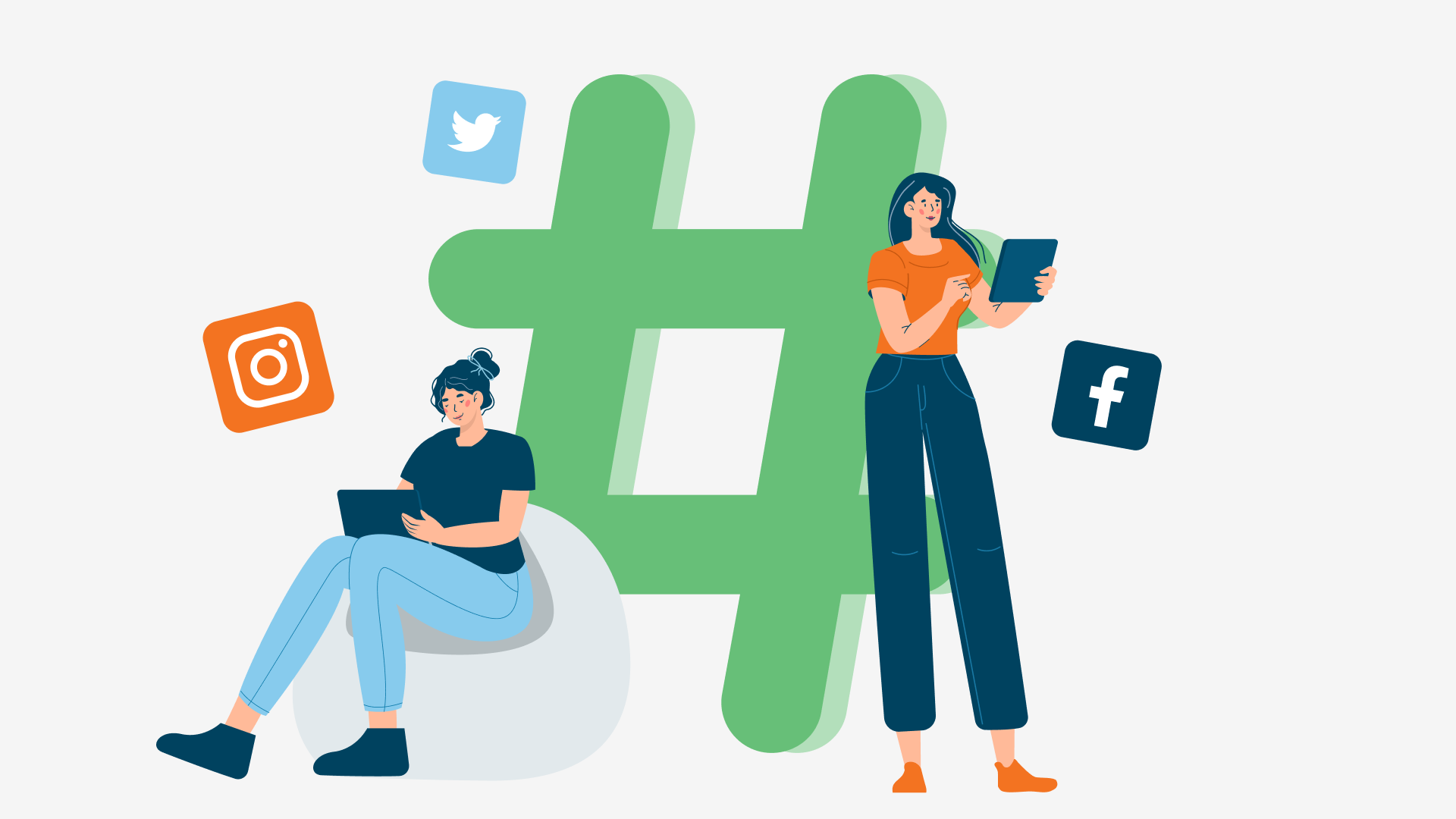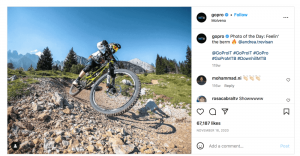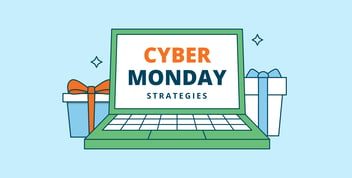From Trending to Thriving: 11 Marketing Hashtags to Maximize Your Reach
Anyone can use a hashtag or two in their social media posts. But using hashtags effectively is more than just making a #MotivationMonday post on Twitter.
If you want to maximize their potential, you’ll need to know how to use them and which ones will truly engage audiences.
Used correctly, hashtags can get your content in front of a wider audience, raise brand awareness, and encourage people to talk about your brand.
In this guide, you’ll learn how to effectively use marketing hashtags and discover 11 valuable strategies to grow your brand and boost social media engagement.
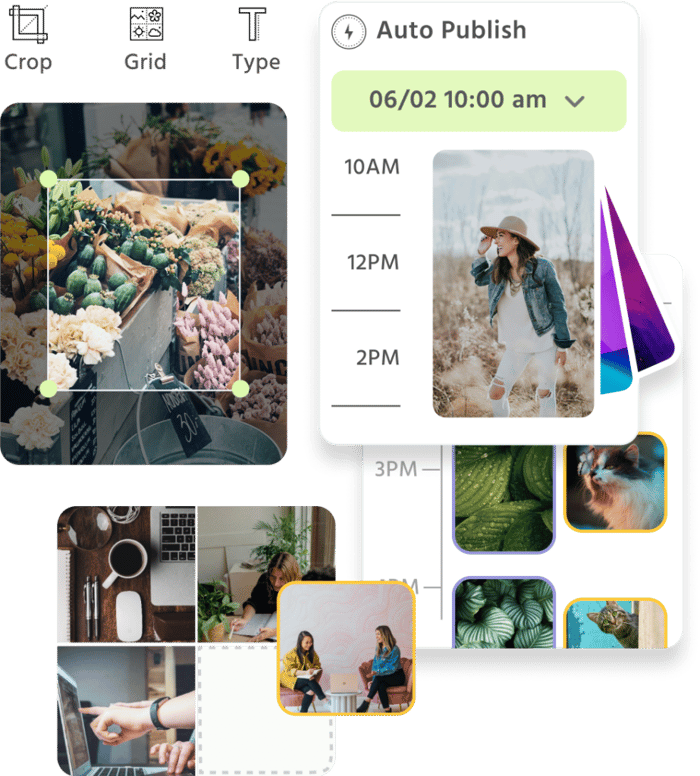
Manage all your social media accounts in one place.
Craft, schedule, & auto-post content to all your social channels, then track analytics and manage interactions from a single, easy-to-use dashboard.
What is a hashtag?
-
- LinkedIn: #marketing
- Twitter: #SocialMedia
- Hashtags are predominantly used on Twitter and Instagram. They’re either included in the main written text or shortly after to signify the topic.
Here are a few hashtag examples on different social media platforms:
A brief history of hashtags
Hashtags were first used on Internet Relay Chats (IRCs) before finding their way onto Twitter in 2007. The first social media hashtag, used by social tech expert Chris Messina, encouraged users to tag topics of interest on Twitter:
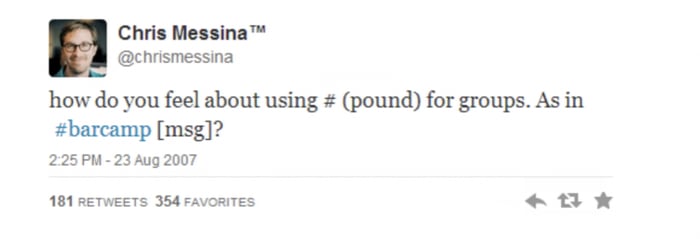
Today, they’re used on many social media platforms, including Instagram, LinkedIn, TikTok, Facebook, Pinterest, and YouTube, as well as TV advertising campaigns.
What is the purpose of marketing hashtags?
Hashtags work in a similar way across social media platforms. Their primary purpose is to help users find content on a specific topic – in other words, they categorize content.
When users click on a hashtag, they’re directed to a list of posts using the same hashtag on the platform. From there, they can easily find and follow topics they’re interested in and engage with users and brands based on a common theme or interest.
For example, hashtags help TikTok users discover new trends on the platform. When you search for the hashtag #healthy, for instance, you can see all the videos published on the platform using that hashtag.
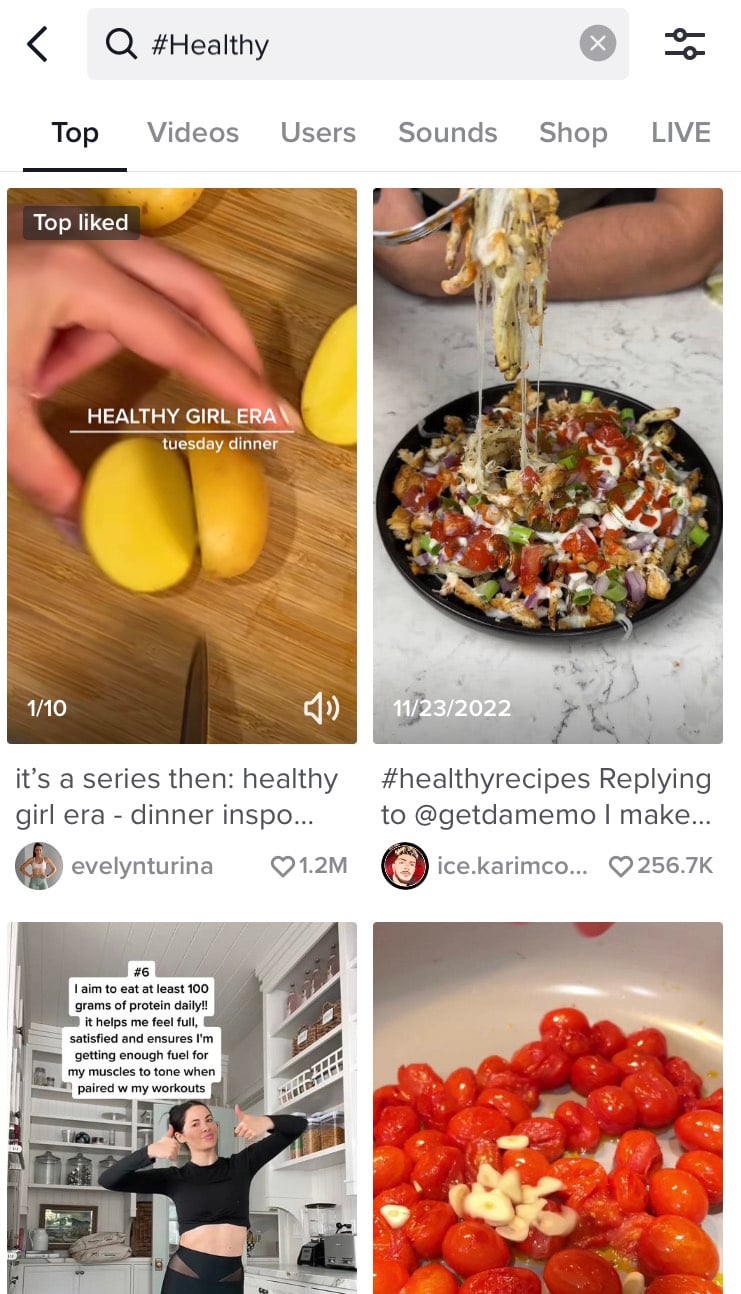
(Original Screenshot)
If you’re a health food or fitness brand, you can use hashtags in your industry as an opportunity to become part of the health community and reach more potential customers.
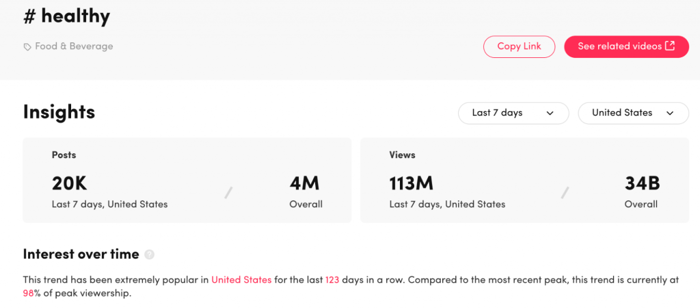
Even a simple hashtag can have a massive reach on social media platforms, generating 34 billion views. From a marketing perspective, adding hashtags to your content increases the visibility and organic reach of your social media posts.
How to use marketing hashtags effectively
Hashtags that are carefully selected and tactically used will unlock their full potential and get the kind of results you want. Here are a few important tips on how to use (and not use) hashtags in your marketing.
Use hashtags correctly by understanding how they work
Familiarizing yourself and keeping up to date with the basics of hashtag best practices ensures you’re using them properly and generating the best results possible. Here are some of the most important tips to remember:
- Hashtags always start with the # symbol, but they won’t work if you use spaces, punctuation or symbols.
- Ensure your social media accounts are public; otherwise, non-followers won’t see your content (including hashtags).
- Avoid using hashtags #ThatAreTooLongOrComplicated since it’ll be hard to read and remember them.
- Avoid using all CAPS LOCK, as it can feel like you’re shouting to your audience.
- Capitalize the first letter of every word in your hashtag for readability — e.g., #SocialMediaMarketing.
- Limit the number of hashtags you use. Too many look spammy.
- Customize your hashtag use according to each platform’s guidelines. For example, Twitter recommends using no more than two hashtags per tweet.
- Always use a hashtag with a goal in mind — i.e., to start a conversation and increase engagement.
Keep your hashtags #relevant to increase your visibility
The main reason for using a hashtag is to grow your audience reach. Therefore, the hashtags you use should relay information relevant to your audience and brand.
- Ensure that every hashtag you use is well-researched, specific, and relevant to your topic, audience, or niche.
- Avoid using broad, generic-only hashtags, as they won’t get you the results you want.
- Your hashtags should give your audience a clear idea about the topic you’re talking about.
Loomly’s Hashtag Suggestions feature recommends hashtags that are trending and relevant to your copy. Want to try it out for yourself? Start your free trial today.
Improve your hashtag strategy by analyzing their performance
Analyzing key metrics and tracking your hashtag performance reveals how (and how well) they’re impacting your social performance.
- Track your branded hashtags to see what people are saying about your brand.
- Track industry hashtags to keep tabs on relevant news and trends.
- Check the performance of your hashtags so you can adjust accordingly.
- Create a hashtag marketing strategy using different hashtags across all types of content.
To ensure your hashtag strategy is working, find a social media management tool that offers analytics. Loomly’s Analytics helps you measure your social media post performance, including which topics and types of content your audience is most interested in.
Hashtag best practices for all major social platforms
A successful hashtag strategy starts with recognizing what works on each social media platform.
How to use hashtags on Twitter
- Optimal number of hashtags to use: 1–2
- You can:
- Use as many hashtags as you’d like, but Twitter recommends using no more than two hashtags per Tweet.
- Include hashtags anywhere in your tweets, retweets, replies, and your bio.
- Find hashtagged content by entering a hashtag into Twitter’s search bar.
- Discover trending hashtags in Twitter’s trending topics.
How to use hashtags on Instagram
- Optimal number of hashtags to use: 3-5
- You can:
How to use hashtags on LinkedIn
- Optimal number of hashtags to use: 1–2
- You can:
- Place hashtags anywhere in your posts and articles.
- Search for hashtags in the LinkedIn search bar.
- Get hashtag suggestions from LinkedIn when writing a post.
- See recommended hashtags in the right-hand sidebar menu on the home page.
How to use hashtags on Facebook
- Optimal number of hashtags to use: 1–2
- You can:
- Include hashtags in your posts or comments.
- Use hashtags to group content in private Facebook groups by theme or topic.
- Search for a hashtag in the Facebook search bar.
- Click on a hashtag to see more posts using the same hashtag.
How to use hashtags on Pinterest
-
- Optimal number of hashtags to use: 2–5
- You can:
- Include hashtags when writing a Pin description or when Repinning, but don’t use more than 20
- Get hashtag suggestions when creating a new Pin.
- Use hashtags that contain relevant keywords so they’re searchable in Pinterest’s search engine.
How to use hashtags on YouTube
-
- Optimal number of hashtags to use: 2–3
- You can include a few (but no more than 15) hashtags in your brand’s YouTube video title or description.
- Click on a hyperlinked hashtag to see other videos using the same hashtag.
- Note: If you don’t include hashtags in the title, the first three hashtags in the description will show above the video title.
Why hashtag marketing matters to your brand
Every marketer knows how important marketing hashtags are for their social media strategy. Hashtag marketing uses strategic hashtags to help your content get seen by the right audience, raise brand awareness, and get more people talking about you or your brand.
1. Makes your content easily discoverable
Hashtags categorize your content so you can attract any users searching for a particular hashtag, not just your regular followers.
Using relevant and popular marketing hashtags boosts your organic search, getting you in front of a larger audience and increasing your reach and brand exposure on social media platforms.
According to Twitter, when brands connect with what’s happening on the platform, they see an 8% or higher increase in brand awareness.
2. Encourages audience engagement
Hashtags increase your chances of engagement — aka how much your audience interacts with your content through likes, comments, retweets, replies, and so on.
Hashtags can open up conversations for your audience, depending on which social platform you are using. According to Twitter, tweets with hashtags can double engagement for individuals and increase engagement by 50% for brands.
For example, you can keep users engaged by using hashtags that provide them with some sort of direction to stir up conversation about your brand. KitKat’s #haveabreak hashtag encourages users to share their breaks using the popular hashtag, generating tons of engagement with the brand.
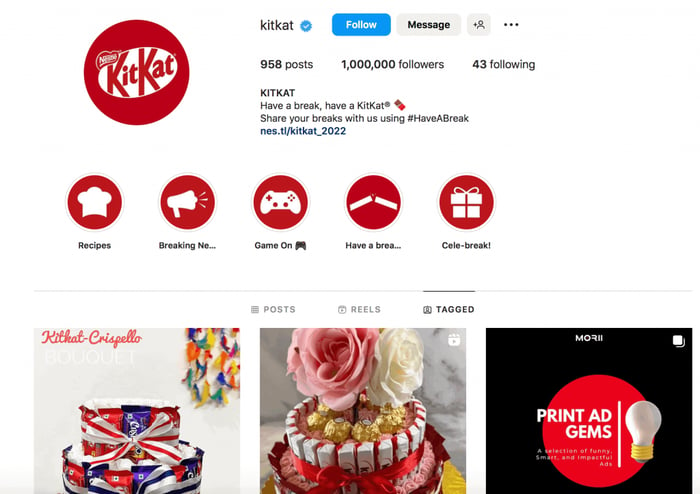
3. Helps you start (or join) a relevant conversation
Hashtags are a powerful way to cultivate conversations on social media with your target audience. For example, Twitter has designated Twitter Chats, which are usually held on a regular schedule. Twitter Chats give brands or individuals the opportunity to engage users in an online conversation about a specific topic.
SEMrush is one of the best examples of how a brand can leverage Twitter Chats to engage with followers and build brand trust. Their wildly popular #SEMrushChat series was an educational chat that shared best practices in the digital marketing world.
Hey hey hey, friends! Happy Wednesday, everyone!
We are about to kick-off another rocking #SEMrushChat!
Let's start the chat by sharing some positive vibes: what little thing made you happy this week? pic.twitter.com/SNLwAb5Jgm
— Semrush (@semrush) November 11, 2020
While SEMrush decided to end its successful series in 2021, it’s had an estimated reach of more than a million people since its inception in 2014.
Hashtags also help you find themes and topics related to your brand and join in on the conversation. Consider attending a few chats related to your brand or offering to guest host an established Twitter Chat.
4. Helps you take advantage of #trending topics
Trending topics occur on all social media platforms and attract a huge number of readers. Take the infamous Will Smith incident at the 2022 Oscars ceremony, immortalized by the hashtags #TheSlapHeardAroundTheWorld.
Now, we’re not saying to capitalize on a controversial hashtag or event. However, using certain trending hashtags wisely can give your brand or small business more exposure.
Trending hashtags can help you find out what’s holding consumer interest and get your product, service, brand, or content in front of a massive audience. And while it’s not a long-term strategy, they can be used in the moment to capitalize on a trending topic.
11 powerful marketing hashtags your brand can leverage now
Let’s explore how you can use hashtags in your marketing strategy.
1. Branded hashtags
Creating a branded hashtag is probably the most important strategy to use. Branded hashtags can contain your brand name, tagline, slogan, or product/service names. For example, Nike often uses its famous tagline #JustDoIt while action camera GoPro uses its brand name #GoPro.
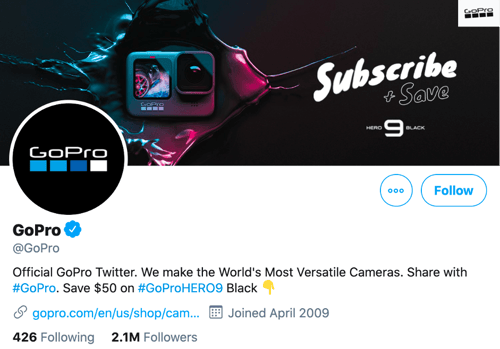
Once you’ve created a branded hashtag, you can use it across all platforms and types of social media content so that it becomes an easy way for people to find out about your brand. You can also ask your followers to use it in their posts to help promote your brand.
Branded hashtags help you distinguish your posts and also offer a way of tracking untagged (those without your name) shares of your posts.
As author and LinkedIn coach John Espirian explains,
“As well as being a useful personal branding tool, hashtags… help you find “untagged” shares of your content.
If you use a branded hashtag in your original post, then searches on that hashtag should reveal shares that others have made on that post.”
By using one of his branded hashtags, such as #LinkedInLearnerLounge, John can check how far his brand is reaching:
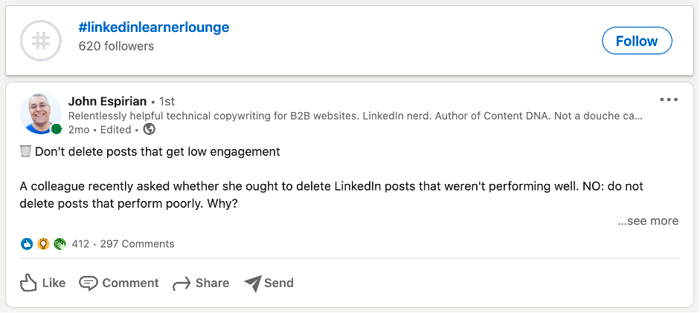
2. Campaign hashtags
Campaign hashtags are similar to branded hashtags as they’re unique to your brand. However, the key difference is that you only use them for the period of a specific marketing campaign.
As well as using their famous tagline #JustDoIt, Nike also creates specific campaign hashtags, such as the inspirational #YouCantStopUs campaign in the wake of the coronavirus pandemic.
Nike uses community-building hashtags that are punchy and compelling, generating conversation on social media and building a sense of community.
No matter what we’re up against, we are never too far down to come back. #YouCantStopUs pic.twitter.com/GKVHcTRzA8
— Nike (@Nike) May 23, 2020
Nike uses community-building hashtags that are punchy and compelling, generating conversation on social media and building a sense of community.
3. Community hashtags
As well as helping to build your brand, hashtags can help create a community around your brand. As your community grows, so does the reach of your brand.
Community hashtags drive more loyalty and customer advocacy than generic hashtags. That’s because customers feel more connected to other members of the brand’s “tribe.” This tag tends to produce high-quality, user-generated content.
Camera brand GoPro encourages owners to share action photos using its #GoPro hashtag. GoPro then shares a “photo of the day,” naming the user who took the shot building a collection of user-generated content.
Using this hashtag strategy, GoPro has been able to produce a brand with world-wide recognition with a small marketing budget.
4. Trending hashtags
Another popular hashtag strategy is to jump on trending hashtags (but only if they’re relevant to your brand!). Trending hashtags are typically fast-paced, short-lived, and a little unpredictable.
The downside is that your post(s) might get lost in a mass of content if a trending hashtag goes viral.
If you’re looking to boost your presence on TikTok, their Creative Center lets you browse the top trending hashtags in each country from the last 7, 30, or 120 days.
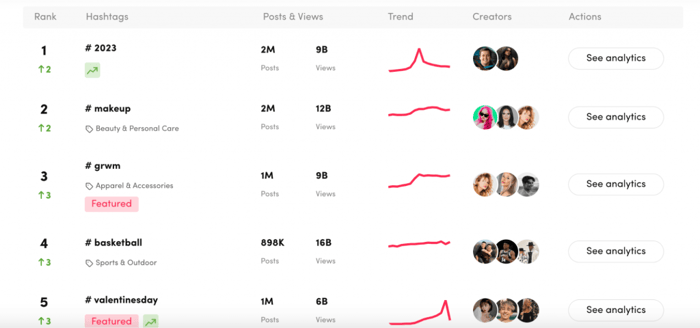
TikTok even provides detailed insights about each hashtag, such as the number of views or viewer demographics.
But before you jump on a trend, make sure to research trending hashtags that are relevant to your audience.
5. Event hashtags
Similar to campaign hashtags, event hashtags have a start and end date. Some annual events may use the same hashtag. For example, the Masters Golf Tournament uses the evergreen hashtag #themasters each year:
Dustin Johnson wins the 84th Masters Tournament. #themasters pic.twitter.com/aI2zjbuE7h
— The Masters (@TheMasters) November 15, 2020
Other events include a year, such as #Paris2024 for the 2024 Olympic Games to be held in Paris:
Event hashtags are a great way to build awareness and visibility for your upcoming events. Use them at every stage of the event for maximum exposure:
- Before the event, to generate awareness
- During the event to engage with attendees and spark up online conversation
- After to keep the conversation going
The best event hashtags are short, relevant, memorable, and unique.
6. Holiday hashtags
Some holidays have their own hashtags, such as American Independence Day’s #4thofJuly. As well as holidays, there are fixed dates for other global or national days, weeks, and months, such as:
- #WorldDiabetesDay
- #MentalHealthAwarenessWeek
- #Movember
‘Movember Is Good For You’ is some research we undertook to explored whether guys who sign up for #Movember experience better physical and mental wellbeing compared with guys in the general population.
And we confirmed they do. pic.twitter.com/17GBNak8gI
— Movember USA (@Movember) November 18, 2020
Popular holiday hashtags are a good opportunity to piggyback on trending content that users engage with. Choose hashtag holidays relevant to your brand, and make sure you plan and schedule your content around these fixed dates in your social media calendar.
For example, if your brand has strong corporate responsibility initiatives, the hashtag and environmental movement #Earthday is the perfect opportunity for you to post and highlight that.
7. Location hashtags
Location hashtags are especially useful for local businesses that want to target their local audience. By simply adding a location tag to a post, businesses get put on the radar of their local community.
For example, a New York-based restaurant could use the hashtag #NewYorkRestaurant to attract local customers who are specifically searching for restaurants in New York.
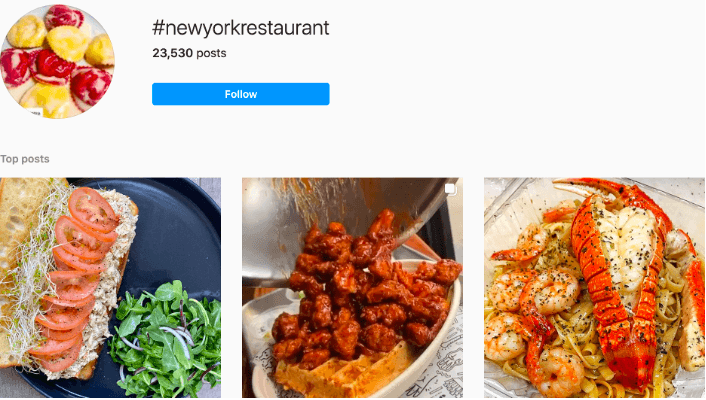
8. Niche hashtags
Niche hashtags let you get ultra-specific about your brand. Niche hashtags are more unique and less popular than general industry hashtags, and they can increase Instagram post engagement to people who have more specific search terms.
For example, Anthia from @thesaltybiscotti isn’t just a photographer but a specialist food photographer based in Athens. So she uses the niche hashtag #foodphotograhy in her posts:
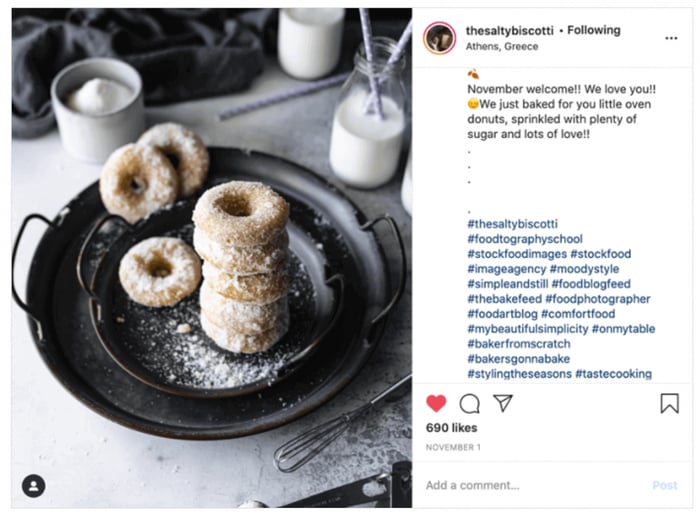
Using niche hashtags, Anthia has a better chance of getting discovered by her target audience.
9. Contest, giveaway, and challenge hashtags
Everyone loves a contest or a giveaway, and they’re great for boosting user engagement. A quick search on social media for #giveway usually reveals a huge number of posts, so you’ll need to add another hashtag or two to link your brand to a giveaway.
Entrants typically have to follow a brand and tag a friend to enter the giveaway or contest, so it’s a way of increasing your followers and generating brand awareness.
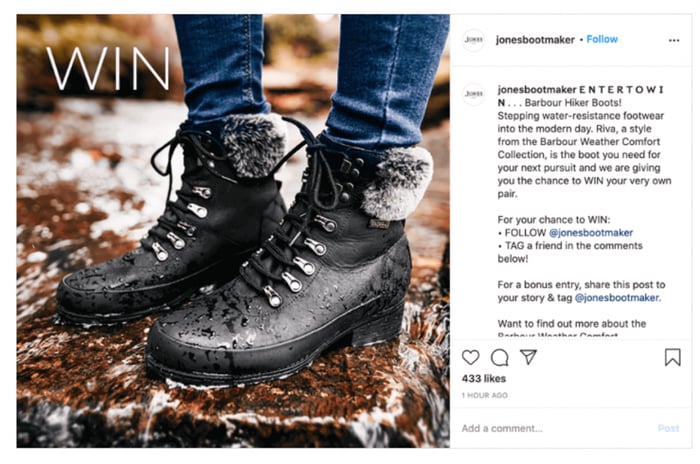
Another excellent hashtag marketing strategy is the social media challenge, which is especially popular on TikTok. All you have to do is start a social media challenge and use your unique hashtag to promote it.
For instance, to announce their arrival on TikTok, rock band Queen launched their #SingWithFreddie challenge, where users had to record themselves echoing lead singer Freddie Mercury:
Turning your audience into active participants using contest or giveaway hashtags is a modern and highly effective approach to digital marketing. Brands that leverage branded hashtag challenges can ignite massive engagement and increase organic visibility.
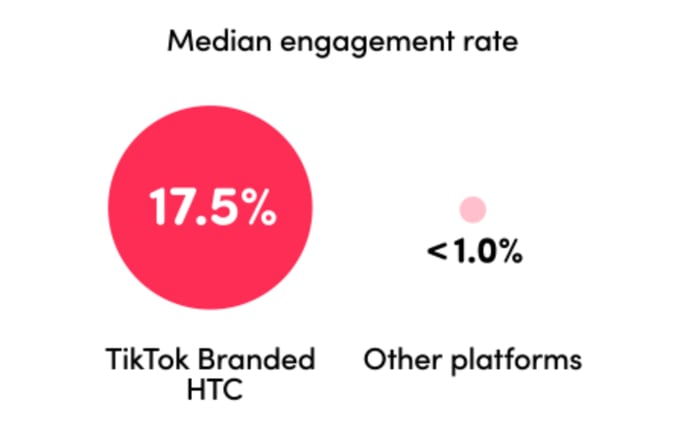
TikTok is the platform for branded hashtag challenges, generating significantly more engagement than other social media platforms.
10. Daily hashtags
Daily hashtags are always trending, and if used correctly, they’re an easy way to boost your reach and engagement. From #MondayBlues to #SundayFunday, there are plenty of daily hashtags to leverage for social content:
- #TravelTuesday
- #TransformationTuesday
- #WCW (WomanCrushWednesday)
- #TBT (ThrowbackThursday)
Used strategically, daily hashtags can help easily come up with social media posts and build your following through consistent posting.
11. Content hashtags
Content hashtags are simply hashtags related to your content that add some context. For example, a tweet about social media may contain #digitalmarketing, or an Instagram post on food might contain #instafood.
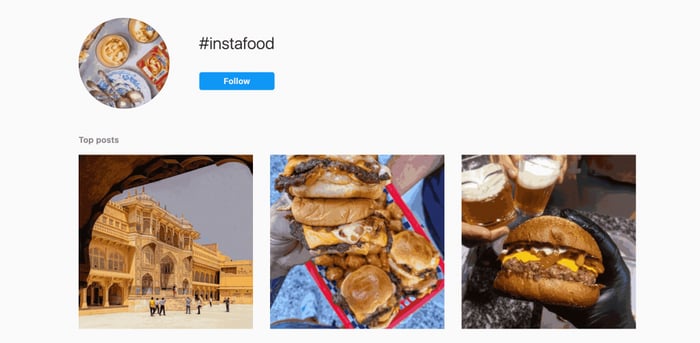
If you’re a restaurant owner, for instance, using one to two content hashtags like #instafood or #foodie could significantly boost your brand’s digital reach.
The top marketing hashtags for you to implement
If you are looking for a way to make your brand stand out in the social media marketing space and want to use the latest and greatest hashtags related to marketing, here are the top 10 hashtags we have seen in the marketing world in 2024:
#1 #marketing
#2 #marketingstrategy
#3 #marketingdigital
#4 #marketingtips
#5 #socialmediamarketingtips
#6 #marketingconsulting
#7 onlinemarketing
#8 #b2bmarketing
#9 #digitalmarketing
#10 #marketingexpert
Lists like these can easily be compiled and updated using Loomly’s Hashtag Manager & Suggestion Tool.
Build and grow your brand with marketing hashtags
Hashtags may seem simple, but they’re vital for helping your audience find and engage with you.
While they were initially invented to categorize content, marketing hashtags have evolved into a powerful marketing tool. Hashtag marketing strategies can extend your brand’s reach, boost brand awareness, increase user engagement, and make your content more discoverable.
Try implementing the hashtag strategies above in your social media marketing to see how effectively they work for you.
